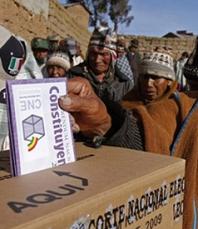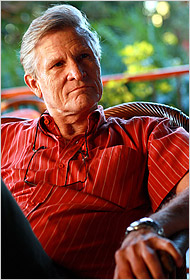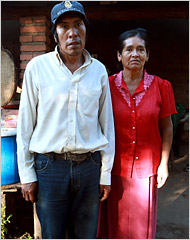By Les Blough, Editor. Axis of Logic
 |
In Walata Chico, Bolivia, Aymara Indian men cast their ballots for a new constitution.
(Photo: Juan Karita/AP) |
Bolivia's passing of the new constitution today represents a clear victory for the indigenous people and for the administration of President Evo Morales. Likewise, it represents a defeat for Bolivia's opposition forces who have resorted to fascist tactics to reinforce their oligarchy. Much has been published about their attempt to to sever the gas-rich states from the rest of the country, leaving the indigenous population with the leftover crumbs of the national economy.
Right Wing Violence
Since 2007, the right wing oligarchy has led a fierce campaign against the government and against the rewriting of the constitution. Big landowners, and those who want to retain control of the gas-rich states, backed by their hand-picked politicians, organized violent battles against the government. Some were responsible for the killing of Morales supporters in September, 2008. Federico Fuentes reported from Bolivia on the violence at that time:
"... a three-week offensive of violence and terrorism launched by the US-backed right-wing opposition denounced by Bolivian President Evo Morales as a "civil coup". This campaign of terror, centred on the four resource-rich eastern departments (Santa Cruz, Pando, Beni and Tarija) The worst violence occurred on September 11, with the massacre in Pando of unarmed indigenous campesinos — including children and pregnant women — who were marching against the racist violence. It was carried out by paramilitaries created and controlled by Pando prefect Leopoldo Fernandez, since arrested over the atrocity. At least 30 people were slaughtered, with more than 100 still missing.
"The violence was an attempt to impose by force what was lost at the ballot box. Violently assaulting civilians, police officers and soldiers, occupying and burning public buildings, blowing up gas pipelines, and blockading roads were among the tactics of the pro-neoliberal forces of the opposition, which utlitised fascist shock troops of racist armed youth gangs, such as the Santa Cruz Youth Union (UJC)."
Morales has fought the opposition on a number of fronts and has taken some dramatic measures against imperialism. In November, when the Morales administration sent Goldberg packing back to Washington due to Goldberg's involvement in the opposition's violent bid to rend the country. More recently, he booted Israel's diplomatic corps out of the country and seeks charges of war crimes against Israel in the Hague, in protest to the Israeli slaughter of the people of Gaza.
Criticism from the Left
However, many on the Left think that Morales has compromised far too much with the U.S.-backed oligarchs. Axis of Logic columnist, James Petras is among the best informed writers on the history of mass movements in Bolivia and the early political life and subsequent presidency of Evo Morales. Regarding the expulsion of Philp Goldberg, Petras wrote:
"President Morales finally ordered the US Ambassador Phillip Goldberg to leave the country after 2 years of direct intervention in the planning, financing and backing of the organized neo-fascist class warfare and seizure of regional power. Over $125 million in AID funds financed almost exclusively the neo-fascist ‘civic’ organizations and through them the armed racial vigilante ‘Santa Cruz Union of Youth’. Morales’ long-awaited declaration of a state of siege only came about under pressure of his restless supporters among the peasant and urban mass movements who began to organize and arm themselves independently of the impotent federal government."
in the same article, Petras wrote ...
"Despite winning nearly 70% of the national vote in the recall election of August 10, 2008, Morales has not taken a single measure to counter the fascist seizure of regional power – continuing to plead for dialogue and compromise, as the far right gathers strength and prepares to engage in violent civil warfare against the poor and indigenous Bolivians."
The recent path that has led to today's vote has been difficult. The battle for this new constitution was not easily won and in some ways has only begun. Petras isn't alone in his views that the government has let the people down when they had the upper hand and that Morales has been too soft on the opposing forces. Concessions were made at the negotiating table with which others on the Left are also not pleased. Writing for Truthout, Benjamin Dangl accurately states:
"There are many valid criticisms of the constitution from the left - that the document won't allow for the breakup of existing large land holdings ... that it doesn't go far enough in combating neoliberalism, that there exists a lot of vague language about how these changes will be implemented, and more."
Land Reform
There is much to say about control of Bolivia's water, natural gas, coca and other natural resources, but we will instead focus on the issue of Land Reform. Land redistribution has been one of the hottest issues for the government and in the writing of this constitution. The new constitution limits future land holdings to either 12,000 or 24,000 acres (5,000 or 10,000 hectares), leaving the choice to the voters. But this limit does not apply to the powerful big landowners today who hold massive tracts of land for cattle ranches and soy - at the expense of the indigenous population in terms of food, water, money and power.
 |
| Ronald Larsen, immigrant from the U.S. controls 140,000 acres of land in Santa Cruz, Bolivia |
One such landholder is Ronald Larsen who controls about 140,000 acres of land and views himself as a colonial cowboy from the old west. He's an immigrant from the U.S. On Larsen's 37,000-acre Caraparicito ranch in Santa Cruz, "senior farmhands" earn less than $6 a day. Larson kidnapped Bolivia's Deputy Land Minister and held him on his ranch for a day. Larsen stated to La Razon, a newspaper, "I didn’t want this guy making any trouble, so I shut him up with a shot at one of his tires.” Later when facing legal proceedings, he denied shooting at Larson and bragged, "If I’d have been shooting at people that day, there would have been dead and injured." Later Larsen told the NYT,“They’re taking it (land) away over my dead body.” The NYT was more sympathetic to him than to the Bolivian people, presenting Larsen as a hero figure and describing him as "resembling Clint Eastwood."
 |
| "Guaraní Indians employed by Mr. Larsen" is the way the NYT describes them. Together, they earn less than $6 a day on Ronald Larson's 37,000 acre ranch. The NYT forgot to ask for their names. |
May I digress even further for a bit, only to give the reader even more of an idea about the people with whom President Morales is dealing (not unlike the opposition in Venezuela, by the way). Now that I think more about it, it's not really that much of a digression from the battle of the indigenous people to own their own natural resources and govern their own lives. The NYT (with a smattering of admiration) tells the story of Ronald's eldest son, Duston:
"... his oldest son, Duston, born in Bolivia, reared in Nebraska and educated at Montana State University. While Mr. Larsen prefers to lie low at the family home in Santa Cruz, the provincial capital, Duston, 29, has been in the spotlight since moving here in 2004. Within months of his arrival, he won the Mr. Bolivia beauty pageant. He compensated for his American-accented Spanish at the finale by shouting, 'Viva Bolivia!' before the stunned judges. Shortly afterward, he was cast as himself in a Bolivian comedy about cocaine smuggling entitled 'Who Killed the White Llama?'
Mixing a little truth and compassion into their praise of the Larson family, NYT tells us what Duston is doing today.
"Now Duston Larsen is focused on guarding the family’s land, ahead of his marriage to Claudia Azaeda, a talk show host and former beauty pageant winner. Depicted in newspaper cartoons as a gun-slinging 'Mr. Gringo Bolivia,' he basks in the showdown with Mr. Morales, an Aymara Indian who as Bolivia’s first indigenous president has made land reform a top priority in his efforts to reverse centuries of subjugation of the indigenous majority.
“ 'Evo Morales is a symbol of ignorance, having never even finished high school', Duston Larsen said."
(When reading about "settlers" like the Larsens, I cannot help but think of the "settlers" from Brooklyn and Long Island in Gaza and the West Bank.)
The Long Road
When nearly 60% of the electorate voted to pass the new constitution today, they have come a long way to gain their rightful place in Bolivian society, for the first time since Spanish conquerer, Pizarro arrived there in 1531. Bolivia has the largest indigenous population in Latin America. The road to Bolivia's independence and sovereignty has been long and is dyed red with indigenous blood. They drove the Spanish out in 1825, naming their country after the Liberator, Simon Bolivar who established Bolivia as a nation. In the War of the Pacific (1879-1883) Bolivia lost it's coastline to Chile and became landlocked. Peru, Brazil and Argentina have also ripped into Bolivia's economy and natural resources.
Stephen Zunes provides a concise history of U.S. intervention in Bolivia which indicates that Washington and U.S. corporations haven't taken their hand out of the Bolivian pie since the early 1950s. With interest in Bolivia's natural resources, the U.S. used its economic power to gain control of a mass peasant movement (Movimiento Nacionalista Revolucionario - MNR) that successfully rose up against a former military regime in 1952. The United States backed the dictatorial regime of René Barrientos, who seized power in a 1964 military coup. The CIA and U.S. Special Forces also played a key role in suppressing a mass uprising by peasants led by Che Guevara and others and ultimately had Che murdered in 1967. Throughout the years, economic dependency on the U.S. has been cultivated through oppressive IMF programs which left two-thirds of the Bolivian people in poverty. The extreme exploitation of Bolivia's indigenous people by the United States continues to this day and European corporations also continue rob their economy and natural resources. The Morales government has it's hands full, battling the neoliberal policies employed by both the U.S. and Europe.
Conclusion
Bolivians' vote for a new constitution today demonstrates their support for the Morales government, a march toward real sovereignty and empowerment of the masses. Their young and imperfect socialism is fragile, however, and they will continue to face significant threats by the U.S.-backed opposition in conjunction with the old Bolivian oligarchy in the future. They have our utmost respect and we hold them in highest esteem.
© Copyright 2009 by AxisofLogic.com
This material is available for republication as long as reprints include verbatim copy of the article in its entirety, respecting its integrity. Reprints must cite the author and Axis of Logic as the original source including a "live link" to the article. Thank you!
READ BIO AND ADDITIONAL ARTICLES BY LES BLOUGH

